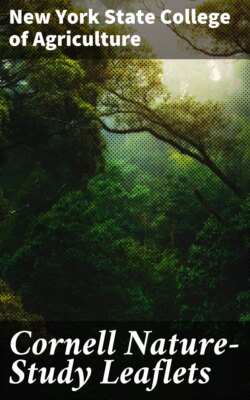Читать книгу Cornell Nature-Study Leaflets - New York State College of Agriculture - Страница 18
На сайте Литреса книга снята с продажи.
Third Grade.
ОглавлениеThe general subject of this year's work may well be the Homes of Insects. This is a most interesting topic, and if well taught will inspire the pupils to much individual observation and collecting.
The questions to be asked concerning insect homes are:
Of what material are they made? How are they made? What is the purpose of the home? Is it made by the insect for itself to live in, or is it made by the mother for the protection of her young? Is it made as a protection for the insects while they are eating, or do they go out to feed and come back only to rest and spend the night or day?
Fall work.—Leaf rollers: Insect Life, p. 206; Ways of the Six-Footed, p. 119.
Leaf miners: Insect Life, p. 208; Ways of the Six-Footed, p. 29.
Galls: Insect Life, p. 210; Outdoor Studies, pp. 18, 38-39.
Fall web worm: Insect Life, p. 200.
Scallop shell moth: Insect Life, p. 201.
Nests of silver spotted skipper: Insect Life, p. 203; Everyday Butterflies, p. 190.
Bag worms: Insect Life, p. 204. Ant lions: Outdoor Studies, p. 81.
Carpenter bees: Ways of the Six-Footed, p. 108.
Tiger beetle larvæ: Insect Life, pp. 270-272.
All kinds of cocoons are found by the children. Ask concerning the cocoons: Where did you find them? Were they in protected places? Why?
Of these nests there are many more than those mentioned above. In fact, to one who sees what he looks at, every plant, every tree, every fence corner and every foot along the country path contains many most interesting homes. The leaf rollers and leaf miners are the most common and most easily found of all.
Spring work.—The spring work in this subject may be to study the way in which caddice worms make their houses; take a caddice worm out of its house and watch it build another. This is a new phase of the study of caddice worms. Ways of the Six-Footed, p. 133.
Study the homes of beetles under sticks and stones, and find the homes of the engraver beetles under bark. Insect Life, p. 216. This work must necessarily be done by the pupils out of school hours, and their discoveries and specimens of homes should be made topics for lessons for the whole school.
During this term begin a butterfly calendar, made on the same plan as the bird calendar. A collection of butterflies might be started for the schoolroom in connection with the calendar. Study the specimens caught and determine whether they hibernated as adults or chrysalids. If their wings are battered and torn, they spent the winter as adults. If they are bright in colors and their wings perfect, they spent the winter in the chrysalis state.
Hints for collecting insects: Cornell Teachers' Leaflet, No. 7 (No. XVIII, this volume); Insect Life, pp. 283-314 and pp. 48-49. How to Know the Butterflies.
Summary of methods.—The work in the third grade, as outlined, requires a lesson period now and then when single specimens are brought in by individual pupils. Each pupil should examine the specimen, and after that the lesson may be given.
